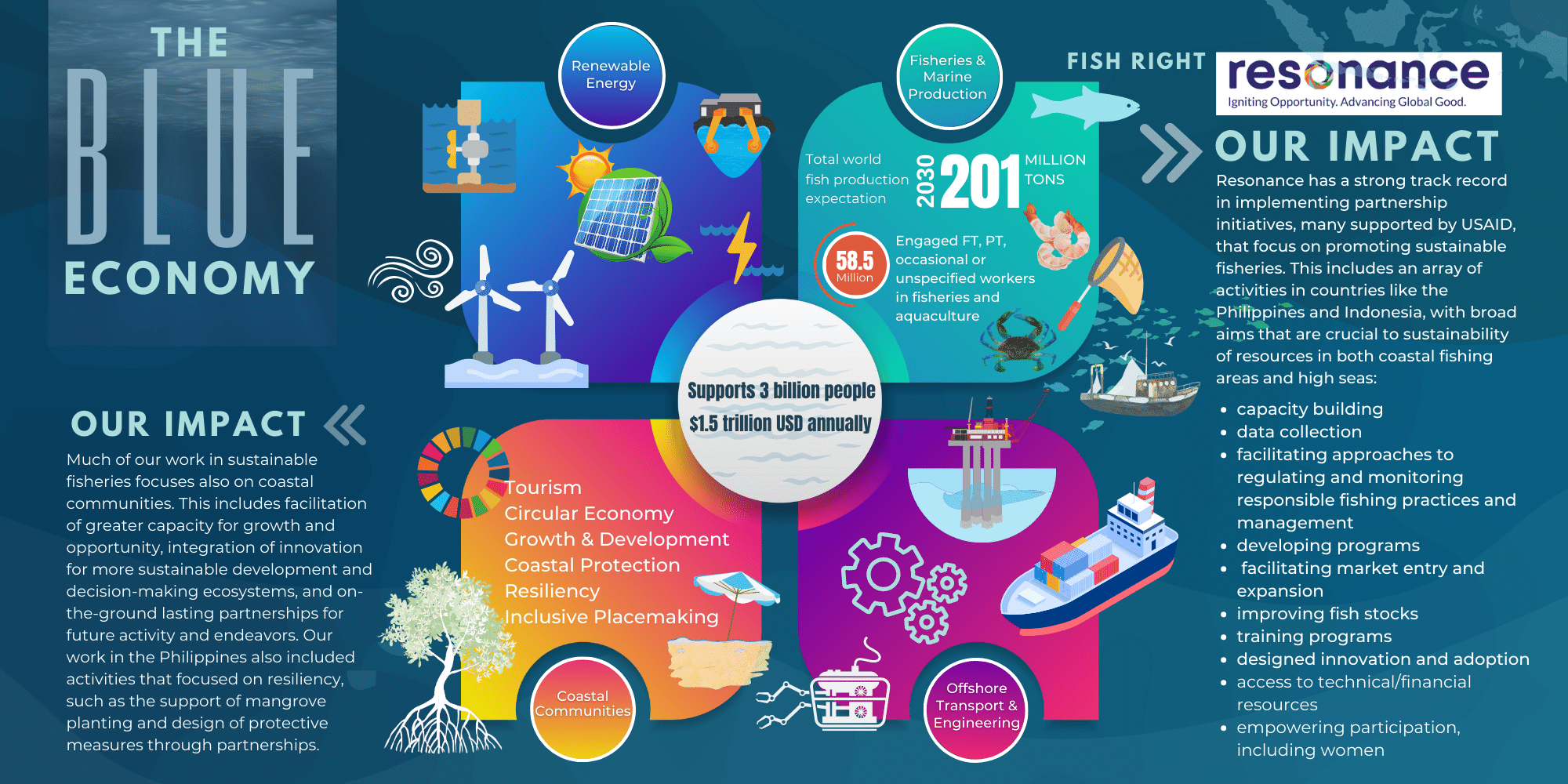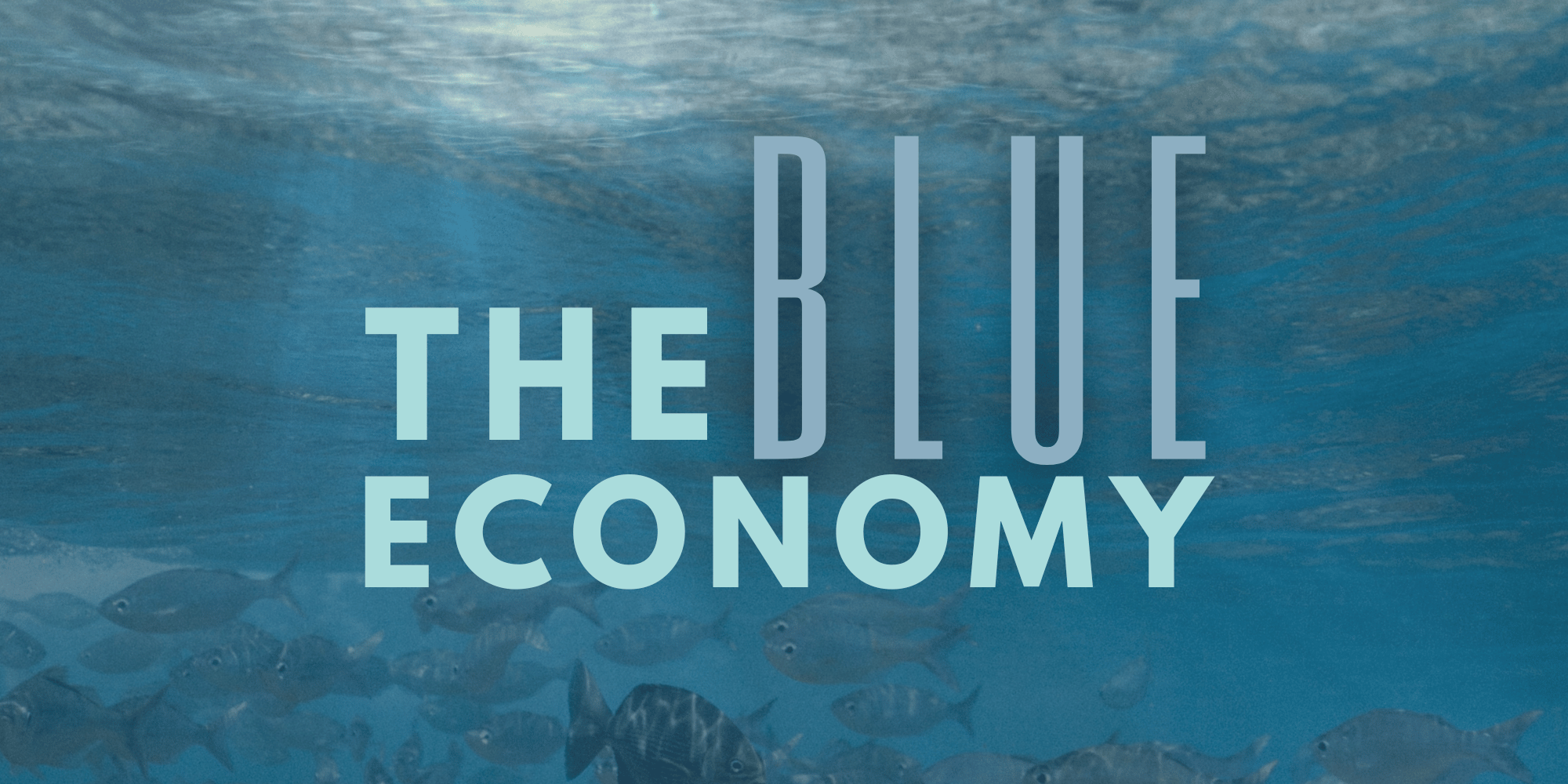Much of our implementing and partnership work in sustainable fisheries, sustainable tourism development, and our most recent efforts in addressing plastics pollution, is inherently part of what is commonly called the “Blue Economy.”
Given our plans for published Insights and Impact Stories in the coming year focused on the progress and impact of this collective body of work, we wanted to offer readers a foundational understanding of what the Blue Economy is (how it is described) and what it often includes.
What is the Blue Economy?
The concept of Blue Economy was coined by the Belgian economist Gunter Pauli in 1994 in response to a United Nations request to prepare for COP3 in Japan where the Kyoto Protocol was decided in 1997.
When we discuss the Blue Economy, we are talking about all economic activity relating to oceans, seas, and coasts, including renewable and marine energy, transport and engineering, fishing, and coastal tourism, as well as business and innovation ecosystem growth and support along shorelines. It also includes other related, but not necessarily production industries like marine research and development (R&D) and education.
Collectively, this is a huge sector, and growing, worth an estimated $1.5 trillion annually, according to the World Bank. By 2030, the Blue Economy, the seventh largest economy in the world, is expected to double to $3 trillion a year, supporting the lives of more than 3-4 billion people by that milestone.
Blue Economy Components and Framing
The figure below illustrates the oft used Blue Economy Components quad, including broadly sectors and focused activities related to Renewable Energy, Fisheries & Marine Production, Offshore Transport & Engineering, and Coastal Communities, We have included mention of our own focused activities, niche specializations, and impact based on our work in the Blue Economy to date, expecting our reach to expand in the coming years with new projects and partnerships. 
Very often, discussions of the Blue Economy are framed in purely economic terms, overlooking necessary inclusion of sustainability of resources, as well as climate change risks, vulnerability, impacts, and resiliency. However, most governments and organizations are recognizing as an imperative to Blue Economy activity the need to maintain a balance between economic development and the sustainability of marine ecosystems and shoreline communities.
Emphasizing this priority, Madhushree Chatterjee, Secretary of UN-Water and current Chief of Natural Resources and Interlinkages Branch at the Division for Sustainable Goals of the Department of Economic and Social Affairs (DESA), stated “The Blue Economy comprises a range of economic sectors and related policies that together determine whether the use of ocean resources is sustainable.”
The Blue Economy and Sustainable Development
The notion that the growing Blue Economy must include not only attentiveness to economic sectors but also policies rests also on the reality that many regions around the globe are lacking in both.
In this context, and that of the UN Sustainable Development Goals (SDG15 – Life Below Water), Andrew Hudson, Head of UNDP Water and Ocean Governance Programme, framed examination of the Blue Economy as taking stock of both the challenges and opportunities through what he called the “sustainable ocean economic paradigm.”
In writing on this model, he reminds us that 'the Ocean' offers humanity numerous benefits – from the provision of oxygen and role in slowing climate change through CO2 absorption and the trapping of excess heat generated from GHG emissions – to its role as an economic driver as a source of 30 percent of global oil and gas. The Blue Economy creates an array of jobs across diverse sectors and serves as a highway for some 90 percent of internally traded goods via shipping. The Blue Economy also provides humanity with a critical source of protein (15% of our daily needs) and a supply of food via small-scale fishing, including some of the poorest shoreline and local communities, providing half the world’s harvested seafood.
At the same time, we would be accused of living in a bubble if we did not recognize that alongside these benefits, a growing Blue Economy also represents immense challenges around sustainability.
In Hudson’s view, the paradigm he outlines is not conceptualized as “benefits vs challenges of the growing Blue Economy,” but rather “two ‘elements’ FOR the Blue Economy.” That is quite a distinction.
In his own words, “The first [element] is the necessity of protecting – and restoring where needed – the existing ocean resource base that already supplies food and livelihoods to billions of people”…“The other side of the Blue Economy is where opportunities may exist for enhanced or new sustainable economic activity derived from the ocean.”
Blue Economy as Sustainability Opportunity
Hudson’s framing presents both elements as opportunities, which many environmental communicators, advocates, and decision-makers believe may be the only compelling framing that will result in the galvanization of stakeholders to usher in necessary breakpoint change to address wicked problems like climate change, biodiversity loss, and sustainability.
The growth in Blue Economy industries like blue biotech, decarbonization of shipping, offshore renewables, aquaculture, natural tide control (mangroves management), shrimp production genetics, carbon sequestration, and ocean deacidification, for example, are among some of many areas that have significant economic potential.
Of course, given links to ecological protection and restoration, as wel as climate mitigation and resiliency efforts, these growing industries and sectors require better scientific understanding through research investment and priority, policy, and institutional support. Innovative finance approaches that expand or augment traditional capital investments, accompanied by innovative governance around investment, have the potential to address these considerations more robustly, while supporting opportunity.
In addition, it has become a given, particularly in the latest rounds of multi-national deliberations on climate, biodiversity, and gatherings on UN SDG progress, that none of this is potentiality possible without private sector engagement (PSE).
Partnerships Critical to Driving Opportunity
Resonance has built significant capacity and expertise in sustainable fisheries given our role in implementing the Tuna Consortium with support from the Walton Foundation, as well also two major USAID-supported projects including Fish Right in the Philippines, recently completed, and our current 5-year Ber-IKAN sustainable fisheries project in Indonesia.
As this work has demonstrated, PSE typically takes the form of cross-sector partnerships and commitments from the public, private, and catalyst sectors to address requisite infrastructural and capacity challenges that support blue industry sustainability, while centering local and Indigenous communities and supporting blue ecosystems. This includes solutions design, often in partnership with technical expertise and localization approaches, evidence-based change management, governance strengthening, and resiliency planning, among other important approaches and activities.
We recently announced the launch of the CIRCLE Alliance: Catalyzing Inclusive, Resilient, Circular Local Economies, a $21 million collaboration founded by Unilever, USAID, and EY. As part of Capitol Hill Ocean Week 2024, USAID Administrator Samantha Power joined Unilever Chief Sustainability Officer Rebecca Marmot, EY Global Vice Chair - Sustainability Amy Brachio, and Senators Sheldon Whitehouse (D-RI) and Dan Sullivan (R-AK) to announce this exciting effort, which will support entrepreneurs and small and medium-sized businesses to scale solutions that reduce plastic use and tackle plastic pollution.
The Alliance builds on the work of Unilever's TRAMSFORM aceleration platform, as well as EY's Ripple Program, both designed to advance their respective corporate ambitous sustainability goals. It also centers USAID and its experience under the Save Our Seas Initiative, which has a goal of ending the flow of plastic pollution into the ocean by 2040.
Dedicated collaborations like these will become even more critical as the Least Developed Countries and Small Island Developing States (SIDS) continue to bear the adverse impacts of ocean pollution, overfishing, and climate change, but also serve as critical suppliers of resources across the globe. This will mean accelerating private sector investment not necessarily as a stand alone approach; rather, as part of well-designed Blue Economy partnerships that:
- Recognize the full range of roles private sector actors can play in partnerships;
- Identify and affirm the interests and goals of all partners in designing, implementing partnership and assessing initiatives for readjustment, pivot and scaling; and
- Ensure adequate understanding of the potential benefits of governance, conservation, and networks for all stakeholders, including the private sector.
As Resonance co-founder and CIO Steve Schmida writes in his book, Partner with a Purpose, these types of challenges must be addressed if meaningful and effective partnerships are to be designed and implemented effectively and for the mutual benefit of partners and stakeholders. With a global interest in ocean health, sustainability, and the growing Blue Economy, innovation and design, technical, facilitation, and implementation expertise will become even more critical to ensure project impact and partnership success.



